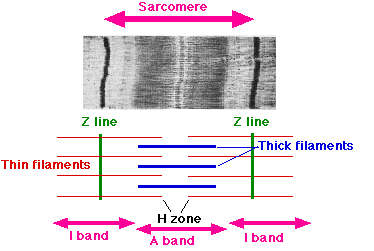Cardiac muscle, like skeletal muscle, appears striated due to the organization of muscle tissue into sarcomeres. While similar to skeletal muscle, cardiac muscle is different in a few ways. Cardiac muscles are composed of tubular cardiomyocytes, or cardiac muscle cells. The cardiomyocytes are composed of tubular myofibrils, which are repeating sections of sarcomeres. Intercalated disks transmit electrical action potentials between sarcomeres.
Sarcomere Structure
A sarcomere is the basic unit of muscle tissue in both cardiac and skeletal muscle. Sarcomeres appear under the microscope as striations, with alternating dark and light bands. Sarcomeres are connected to a plasma membrane, called a sarcolemma, by T-tubules, which speed up the rate of depolarization within the sarcomere.
Individual sarcomeres are composed of long, fibrous proteins that slide past each other when the muscles contract and relax. The two most important proteins within sarcomeres are myosin, which forms a thick, flexible filament, and actin, which forms the thin, more rigid filament. Myosin has a long, fibrous tail and a globular head which binds to actin. The myosin head also binds to ATP, the source of energy for muscle movement. Actin molecules are bound to the Z-disc, which forms the borders of the sarcomere. Together, myosin and actin form myofibrils, the repeating molecular structure of sarcomeres.
Myofibril activity is required for muscle contraction on the molecular level. When ATP binds to myosin, it separates from the actin of the myofibril, which causes a contraction. Muscle contraction is a complex process regulated by calcium influx and the stimulus of electrical impulses.

Muscle Contraction and Actin-Myosin Interactions
Skeletal muscle contracts following activation by an action potential. Binding of Acetylcholine at the motor end plate leads to intracellular calcium release and interactions between myofibrils, eliciting contraction.

The Sarcomere
A single sarcomere unit with all functional areas labeled, including thick and thin filaments, Z lines, H zone, I bands, and A band.
Intercalated Discs
Intercalated discs are gap junctions that link cardiomyocytes so that electrical impulses (action potentials) can travel between cells. In a more general sense, an intercalated disk is any junction that links cells together between a gap in which no other cells exist, such as an extracellular matrix. In cardiac muscle tissue, they are also responsible for transmission of action potentials and calcium during muscle contraction. In cardiac muscle, intercalated discs connecting cardiomyocytes to the syncytium, a multinucleated muscle cell, to support the rapid spread of action potentials and the synchronized contraction of the myocardium. Intercalated discs consist of three types of cell-cell junctions, most of which are found in other tissues besides cardiac muscle:
- Adherens junctions, which anchor actin filaments to cytoplasm of cardiomyocytes.
- Desmosomes, which bind adhesion proteins to the cytoskeleton within cells, thus connecting the cells.
- Gap junctions, which connect proteins to the cytoplasm of different cells and transmit action potentials between both cells, required for cellular depolarization. It is found primarily in nervous and muscular tissue.
Under light microscopy, intercalated discs appear as thin lines dividing adjacent cardiac muscle cells and running perpendicular to the direction of muscle fibers.